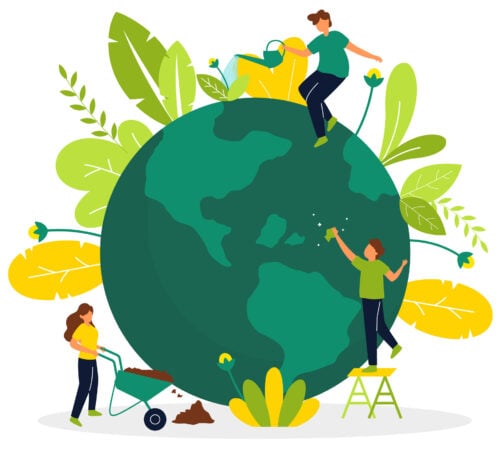
Will using paper again in 2022 cause ecological problems?

What is paper made of?
The answer to this question is quite simple: depending on its thickness and quality, paper contains between 75% and 95% of raw materials known as “fibrous” materials.
Generally speaking, these are cellulose fibers or pulp made from recovered paper, which is reused after cleaning and de-inking.
Other products, such as whitening or coloring pigments, glues and binders, ensure that paper not only looks good, but can also be used for inkjet or laser printing.
Interesting fact: around 45% of the wood harvested each year is used to make paper. And unfortunately, 18% of this comes from trees felled in virgin forests: so there’s inevitably a great deal of ecological damage associated with this industry.
On the European continent, the situation is a little different, as there are no longer any primary forests.
On the other hand, in order to avoid damaging traditional forests too much, we have opted for monoculture by planting large numbers of trees, generally conifers because they grow fast, but at the cost of heavy use of fertilizers and pesticides: the consequence of this situation is that biodiversity is greatly reduced in these artificial forest areas.
How is paper produced? Some interesting figures…
The industrial process of making new paper pulp is a major consumer of natural resources, especially water.
Did you know that it takes around 15 liters of water to produce 1 kilo of paper?
And that this figure drops to 6 liters for recycled paper?
Similarly, it takes between 5,000 and 6,000 kWh of electrical energy to dry a ton of paper made from new cellulose fibers, whereas only 2,500 kWh are required for recycled fibers.
What’s more, manufacturers use a lot of bleaching substances such as chlorine or organochlorine to make paper particularly bright: unfortunately, these chemicals end up in the environment in the form of dioxins, for example…
Finally, to produce 1 tonne of paper, we need to use 2 to 3 tonnes of wood, depending on the variety of species: this corresponds to an average of around 20 trees.
Finally, we now know that the paper industry accounts for around 1.5% of CO2 emissions into the atmosphere, so this is by no means negligible!
Is recycled paper an effective and sustainable solution?
Today, it’s true that paper is increasingly produced from recycled raw materials: today, we know how to manufacture paper using over 50% recovered cellulose fibers.
What’s more, paper quality has greatly improved over the years, and today you can hardly tell the difference between a ream of paper produced from new wood fiber and one based on recycled fiber.
However, there is a technological limit: cellulose fibers cannot be recycled ad infinitum. Cellulose fibers degrade fairly quickly, so we have to increase the percentage of new fibers we add to produce paper that can be used for printing or drawing.
It is generally considered that a fiber can be reused 3 to 5 times.
Finally, the production of paper pulp from reused fibers involves a high consumption of electrical energy: in this sense, the use of digital or digital tools is, in a way, more economical.
What tips can you follow to reduce your ecological footprint when using paper?
First of all, opt for e-mail rather than traditional paper letters when communicating with your contacts.
Don’t overuse your printer either: ask yourself whether the document you’re holding really needs to be transcribed onto paper…
When ordering consumables, choose recycled paper rather than paper made from entirely new fibres.
An important point, but one we don’t pay enough attention to: a sheet of paper has two sides, and we often don’t think to use the blank reverse side, especially if we’re printing a draft!
When it comes to objects made from cellulose fibers, we recommend chlorine-free manufacturing, to avoid environmental pollution.
And don’t forget to be careful when buying items whose packaging is almost or entirely made of paper: other solutions exist, and it may be better to choose to support companies with a more committed eco-responsible approach.
Whenever possible, take your notes on a computer, tablet or smartphone instead: this will avoid having to buy a “paper” notebook or pad!
And don’t forget to “recycle” used paper in your company by depositing it in special bins: it will then be recovered and used to manufacture new fibers!
Is digital “the” answer to today’s ecological problems?
Ideally, yes, but in practice, not always.
Indeed, we understand that many benefits are associated with digital technology and the web in particular, such as very rapid sorting and consultation of documents, easier sharing and perfect accessibility to information in any field.
However, sending or receiving e-mails, storing documents on a cloud or simply printing consumes electrical energy: digital is therefore an interesting solution in terms of environmental protection, compared with paper, but it is not yet “perfect”.
On the other hand, the use of digital business cards (with QR code and NFC chip or not), to take a concrete example, consumes very little energy: this solution is therefore preferable to printing hundreds or even thousands of copies which, as studies tell us, 85% are thrown away without even having been consulted…
Similarly, with the massive arrival of electronic equipment such as computers and servers in businesses and homes alike, it was thought that paper consumption would plummet: unfortunately, the opposite has happened, and some experts even predict that consumption will double by 2030!
We strongly encourage you not to contribute to this rather discouraging reality!
Be discerning and use paper only when really necessary.
In conclusion, we can say that high paper consumption, even in 2022, is likely to exacerbate environmental problems because of the need for natural cellulose fibers and the energy required to manufacture it.
The solution, therefore, is to go digital as soon as possible.
Indeed, this technology is absolutely unrivalled when it comes to disseminating information rapidly and to large numbers of people.
What’s more, it doesn’t use natural raw materials like wood fibers, and therefore doesn’t contribute to deforestation.
On the other hand, in recent years we have seen the massive emergence of “snack content”, a term that designates low-quality content which, unfortunately, uses a lot of energy to produce and store on servers spread across the planet…
In the same way, keeping e-mails in your mailbox that have already been read and are no longer of any use to you consumes storage space and, as a result, unnecessary energy consumption: so delete obsolete documents…
Even with the web and digital technology, it’s important to be and remain eco-responsible so as not to exacerbate the problems of pollution and degradation of natural spaces!
Written by Camille BODET
The digital business card is a real ally for professionals wishing to promote their business effectively and instantly. In the...Lire la suite
VKARD is an innovative and effective solution to help all professionals stand out from the crowd and reinforce their brand...Lire la suite
If you prepare properly for a job interview, you'll have every chance of winning over the recruiter and getting the...Lire la suite
LinkedIn is a world-renowned business platform, and for good reason! Thanks to its many networking options, LinkedIn is the tool...Lire la suite
Find out how Leexi AI optimizes the management of videoconferences and business calls, saving time and improving efficiency.
In the professional sphere, it's vital to know how to convey certain strong values in order to stand out and...Lire la suite
Mastering the art of conversation is a real asset! By mastering the subtle art of conversation, you'll be able to...Lire la suite
Are you taking part in a trade event and want to do everything you can to make a good impression?...Lire la suite
CRM (Customer Relationship Management) represents a genuine corporate strategy for managing business contacts. This popular tool for professionals is in...Lire la suite
At a time when the professional world is in a perpetual state of competition, we might wonder what place altruism,...Lire la suite















